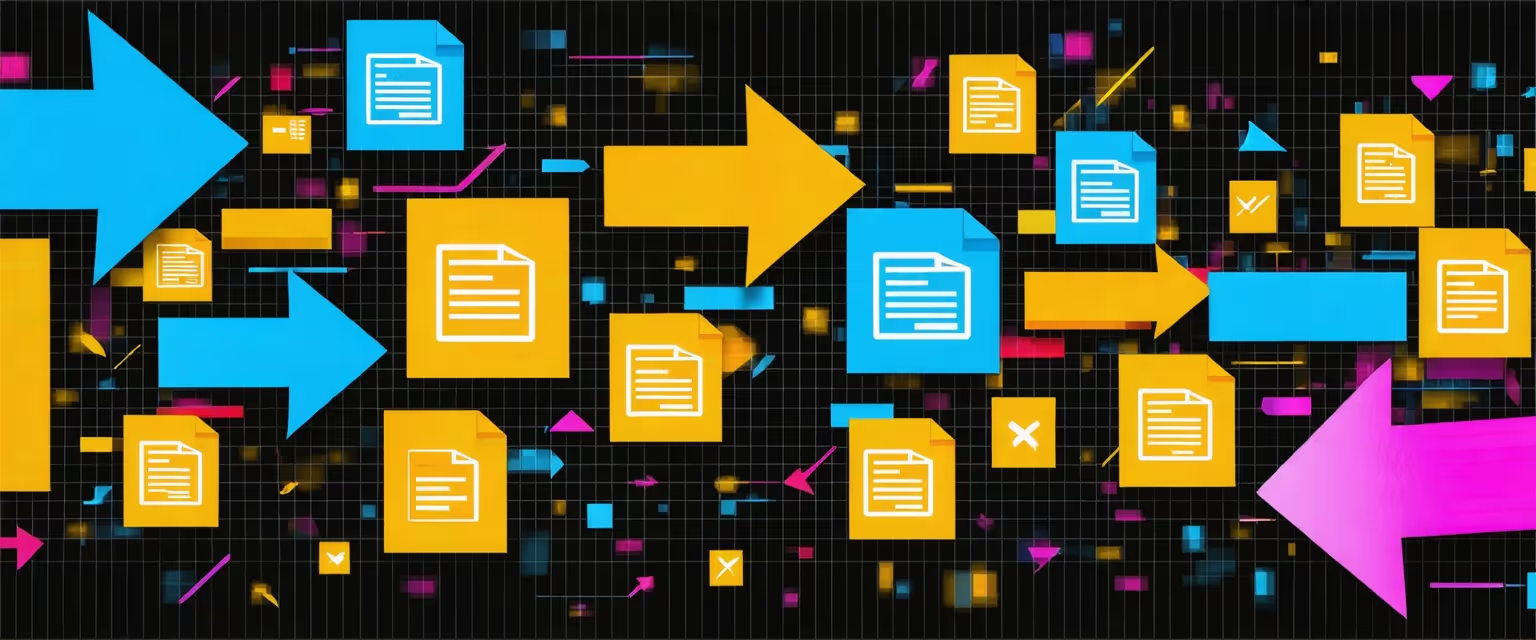All Posts
Document data extraction and handling
Automating Scanned Document Transformation: A Step-by-Step Guide Using Datagrid

Unlock efficiency by learning how to automate scanned document transformation with Datagrid. Streamline operations and gain insights with this practical guide.
Struggling to extract valuable insights from your unstructured data, especially from scanned documents? You're not alone. Understanding how to automate scanned documents transformation is critical in today's data-driven environment.
Data engineers find themselves trapped comparing outputs across multiple screens while efficiency plummets. But there’s good news, Agentic AI now automates these complex data processes, cutting manual task time by 80-90%. This article explores how to automate scanned documents transformation to turn your unstructured data into actionable intelligence, and how Datagrid's data connectors can help you overcome these integration challenges.
How to Automate Scanned Documents Transformation
Scanned documents transformation refers to the evolution of traditional document scanning from simple digitization into an intelligent process that comprehends, interprets, and analyzes document content. Learning how to automate scanned documents transformation is essential in today's business landscape, representing a critical shift in how organizations handle information and streamline operations.
Traditionally, scanning was merely the conversion of physical documents into digital format. Now, with the integration of AI technologies, scanned documents become valuable data assets that can be automatically processed, classified, and incorporated into business workflows. This intelligent transformation extends far beyond basic image capture, enabling businesses to extract actionable insights from previously static documents.
The automation of document transformation delivers significant advantages to modern organizations:
- Enhanced efficiency: By eliminating manual data entry and processing, AI-powered scanning dramatically reduces the time required to handle documents, allowing faster response times and decision-making.
- Improved accuracy: Automated systems minimize human errors that commonly occur during manual document processing, ensuring data integrity across operations.
- Strategic resource allocation: When routine document processing is automated, staff can redirect their focus toward higher-value tasks that require human creativity and problem-solving.
- Cross-industry applications: From healthcare record management to financial document processing, to streamlining sales proposal creation and automating contract comparison in construction, the transformation of scanned documents has applications across virtually every business sector.
As organizations continue their digital transformation journeys, the ability to intelligently process scanned documents has become not just advantageous but essential for maintaining competitive operations in an increasingly data-driven business environment.
Common Challenges in Manually Transforming Scanned Documents
Manual document transformation processes present numerous obstacles that impact efficiency and accuracy. When working with scanned documents without AI assistance, several pain points consistently emerge that can significantly hamper productivity.
The most immediate challenge is the sheer time investment required. Manual data entry from scanned documents is tedious and labor-intensive, particularly when dealing with lengthy or complex materials. This process becomes exponentially more challenging when confronting the reality that approximately 80% of enterprise data exists in unstructured formats, making it difficult to systematically process without advanced tools.
Human error represents another significant hurdle. Manual data entry inevitably introduces mistakes through typos, misreadings, or oversight. These errors compound over time, leading to data quality issues that can impact decision-making and necessitate time-consuming verification processes. The problem worsens when handling documents with poor scan quality, illegible handwritten text, or inconsistent formatting.
Security concerns also arise when manually processing sensitive materials. Documents containing confidential information like financial records, medical data, or personal identifiers require special handling procedures that can further slow down processing while introducing additional complexity to workflows.
For organizations processing high volumes of documents, the limitations of manual transformation become particularly acute. The inability to efficiently scale operations to match increasing document loads creates bottlenecks that impact the entire information management ecosystem.
This scaling challenge partly explains why over half of AI implementation initiatives fail as organizations struggle to develop effective strategies for managing their document processing needs.
Overview of Automation Technologies
Automation technologies have revolutionized document processing, transforming how businesses handle information and creating significant efficiencies across industries. From automating meeting notes to complex data processing, understanding how to automate scanned documents transformation involves leveraging core technologies such as Optical Character Recognition (OCR), artificial intelligence, machine learning, and Intelligent Document Recognition (IDR).
Optical Character Recognition (OCR)
OCR serves as the foundation of document automation, converting visual representations of text—such as scanned images or photographs—into machine-readable, editable text. This technology bridges the gap between physical documents and digital workflows by allowing you to automate PDF conversion and convert scanned documents into searchable, editable content. While traditional OCR is powerful, it's limited to basic text extraction without understanding the context or meaning behind the information.
AI and Machine Learning in Data Processing
Artificial intelligence and machine learning significantly enhance document processing capabilities, contributing to an AI market value in this sector of $1.4 billion in 2022—a figure projected to reach $12.8 billion by 2032. These technologies elevate document processing beyond simple text extraction in several ways, including automating content creation:
- Machine learning algorithms identify data patterns, detect anomalies, and automate the correction of errors, ensuring higher data integrity.
- AI automates validation, cleansing, and deduplication tasks, freeing your team to focus on strategic initiatives such as AI-Driven Sales Proposal Automation and AI-powered strategies.
- Deep learning models continuously improve through exposure to varied document types, enhancing accuracy over time.
The integration of these capabilities transforms OCR from a basic text reading tool into an intelligent system that not only extracts information but also interprets and categorizes it.
Intelligent Document Recognition (IDR)
IDR represents the next evolution in document automation. Building on OCR and AI foundations, IDR systems can recognize text and understand the context of the presented information. This capability is invaluable when dealing with large volumes of data in documents such as invoices, legal papers, or medical records.
Here’s how IDR systems can deliver advanced capabilities:
- Document separation and classification based on content and layout.
- Automated data extraction from semi-structured and unstructured documents.
- Data validation against existing systems, reducing manual intervention.
- Intelligent routing and workflow optimization.
- Integration with business systems for end-to-end automation.
These technologies collectively transform document processing from a manual, error-prone task to an automated, intelligent system that increases accuracy while dramatically reducing processing time.
Step-by-Step Guide on Implementing Automation Processes
Implementing document automation involves three critical phases: digitization, extraction with enrichment, and integration. Understanding how to automate scanned documents transformation effectively requires following these steps to create an efficient document processing workflow.
Document Digitization
The first step in any document automation journey is converting physical or unstructured documents into digital formats. This process typically involves:
- Document scanning: Use high-quality scanners to capture physical documents at appropriate resolutions.
- Optical Character Recognition (OCR): Apply OCR technology to extract text from scanned documents, transforming static images into machine-readable text.
- Format conversion: Convert documents into standardized formats (PDF, TXT, DOCX) that can be processed further.
When implementing OCR, focus on accuracy rather than speed. Poor-quality digitization will significantly impact downstream processes. The AI market for document processing was valued at $1.4 billion in 2022 and is projected to grow to $12.8 billion by 2032, highlighting the importance of this step.
Data Extraction and Enrichment
Once documents are digitized, the next step is extracting meaningful data and enriching it:
- Intelligent Document Processing (IDP): Deploy AI algorithms that go beyond basic OCR to understand document context, categorize document types, and extract specific data points.
- Data transformation: Apply appropriate transformation techniques based on your needs:
- Structural transformation: Modifying data structure and format.
- Content transformation: Cleaning, filtering, or aggregating data, ensuring data quality and compliance.
- Value transformation: Applying mathematical operations or standardization.
- Entity resolution: Identifying and resolving duplicates or inconsistencies.
- Data enrichment: Enhance extracted data with contextual information and metadata to provide greater understanding and relevance. This could include tagging, classification, or adding supplementary information from other sources, such as automating lead enrichment.
Integration and Post-Processing
The final step involves making the transformed data available and useful:
- Data storage: Store processed data in appropriate repositories (databases, data lakes, document management systems) in formats suitable for your use cases.
- API development: Create interfaces that allow other systems to access and utilize the processed data.
- Workflow integration: Connect your document processing pipeline with existing business systems and workflows, such as integrating HubSpot with Zoom to streamline meetings and data flow between platforms.
For integration, you can leverage tools like IBM DataStage, which provides pre-built connectors for seamless data movement between various data warehouses and cloud sources, or Informatica, which supports transformation of data across both cloud and hybrid infrastructures. Similarly, integrating platforms like Salesforce and DocuSign can lead to improved data management and streamlined workflows.
Remember to implement security measures throughout the process, ensuring that sensitive information is properly handled with user authentication and granular access management. This is particularly important when automating document processes that may contain confidential information.
By following these steps systematically, you can create an automated document processing pipeline that efficiently converts physical documents into valuable, accessible digital assets for your organization.
Best Practices for Ensuring Data Accuracy and Security
Training AI models to accurately extract and process data requires a strategic approach, particularly when dealing with different document formats and diverse data types. To maximize the effectiveness of your AI document processing systems, consider these best practices:
Train Models for Specific Formats
When implementing AI for document processing, it's essential to train your models on domain-specific data. Generic models often struggle with specialized content or industry-specific terminology. For document processing tasks:
- Use supervised learning with labeled datasets specific to your document types to improve extraction accuracy.
- Implement various chunking strategies when processing unstructured data, as this significantly affects retrieval accuracy.
- Consider vertically specialized embedding models trained on domain-specific data (such as legal documents or code) for better performance.
Remember that input data quality directly impacts output reliability. Combining technologies like Natural Language Processing (NLP) and Optical Character Recognition (OCR) can enhance input data quality, especially when dealing with poor-quality scans or handwritten text.
Implement Robust Security Protocols
Converting documents into digital formats creates inherent security risks, especially when processing sensitive information like financial records or medical data. To mitigate these risks:
- Develop modularized pipelines designed to automatically secure data at each stage.
- Implement traditional role-based access controls alongside AI-specific safeguards.
- Construct coherent security controls along with guardrails at every stage of the data pipeline, from ingestion to vectorization and consumption.
- Use AI algorithms to identify and flag sensitive information for appropriate protection (access restrictions or encryption).
Security protocols must account for the often inconsistent outputs generated by AI models, requiring comprehensive protection throughout the entire data transformation process.
Maintain Regular Updates and Monitoring
AI document processing systems aren't set-and-forget solutions. They require consistent maintenance to ensure ongoing accuracy and security:
- Schedule regular updates to AI models as document formats evolve.
- Implement new rules in your intelligent document processing solution when standard workflows change.
- Plan for additional training of AI systems when significant changes occur.
- Design scalable solutions that can handle growing data volumes as your business expands.
- Conduct periodic security testing and auditing to ensure compliance with evolving standards.
Continual monitoring and improvement of your AI document processing systems will help maintain data integrity while adapting to changing business needs and security threats.
Tools and Software That Facilitate Scanned Document Automation
When implementing document automation solutions, choosing the right tools is crucial for success. Several powerful platforms currently dominate the market, each with unique strengths for transforming scanned documents into actionable data.
Amazon Web Services
AWS offers a comprehensive ecosystem for document processing through its cloud architecture. What makes AWS particularly valuable is its unparalleled scalability that adapts to growing document volumes. You can build customized solutions using pre-built services like Lambda for functions and Amazon Textract, which excels at extracting data from scanned documents, forms, and tables with high accuracy.
ABBYY FlexiCapture
ABBYY FlexiCapture stands out with its industry-leading OCR capabilities that convert scanned documents and images into editable text. Its machine learning algorithms continuously improve data extraction accuracy over time. With support for over 200 languages, it's exceptionally well-suited for international businesses handling multilingual documents. You can choose between cloud-based deployment or on-premise installation depending on your infrastructure requirements.
Google Document AI
Google's Document AI leverages sophisticated machine learning to automate document processing tasks. Its HITL (human-in-the-loop) technology ensures high data extraction accuracy through human oversight during model training. Being entirely cloud-based eliminates the need for software installation on local machines, while seamless integration with other Google Cloud services creates an efficient document capture and management ecosystem.
Kofax TotalAgility
Kofax TotalAgility offers comprehensive AI capabilities for automating document processing and decision-making. The platform excels at handling various document types including invoices, contracts, and applications. Its workflow automation features streamline repetitive tasks, while built-in regulatory compliance with standards like GDPR and HIPAA enhances document security. The mobile capture functionality allows for convenient document processing on the go.
IBM Datacap
IBM Datacap specializes in extracting specific information from documents, including challenging unstructured data sources like emails or social media posts. Its classification capabilities categorize documents based on type, improving organization and retrieval.
The platform's ability to handle unstructured data expands your document processing capabilities significantly, while its redaction features automatically remove sensitive information for enhanced data security.
When selecting from these options, consider your specific requirements regarding scalability needs, language support requirements, and how the solution will integrate with your existing systems and workflows.
User Considerations
When implementing AI document processing solutions, professionals in finance, insurance, construction, and legal sectors need to consider specific requirements and challenges. These industries deal with complex documentation workflows that have distinct characteristics and compliance requirements.
Industry-Specific Challenges
Finance and Banking
Financial institutions face significant challenges when integrating structured financial data with unstructured documents like financial statements and market analyses. For credit assessments and loan processing, systems need to:
- Extract and validate data from mortgage and loan applications with high accuracy.
- Ensure compliance with changing regulatory requirements.
- Implement robust security measures for sensitive financial information.
- Maintain audit trails for all document processing activities.
Banks and financial institutions that implement IDP can accelerate loan processing while reducing errors. As demonstrated in the SimFin case, adopting machine learning technologies for document extraction significantly reduces document sorting time and improves data quality in financial reports.
Insurance
Insurance companies process large volumes of claims documents that contain both structured and unstructured data. Key considerations include:
- Streamlining claims processing workflows through automated data extraction.
- Enhancing fraud detection through advanced document analysis.
- Ensuring compliance with industry regulations.
- Providing staff with quick access to digitized data for timely decision-making.
By implementing AI-powered IDP solutions, insurance professionals can reduce manual document handling, minimize errors, and accelerate claims resolution timeframes.
Legal and Construction
These sectors rely heavily on contract management and regulatory documentation. Important considerations include:
- Extracting critical information from complex legal documents and contracts.
- Managing document versions and maintaining audit trails.
- Ensuring compliance with industry-specific regulations.
- Organizing and retrieving documents efficiently for reference and dispute resolution.
Cross-Industry Data Challenges
Regardless of industry, all professionals dealing with documentation face common challenges:
Data Security and Compliance
Converting paper documents to digital formats presents security concerns, especially for sensitive materials. It is essential to implement:
- Data security posture management.
- Strict access controls for confidential information.
- Data loss prevention mechanisms.
- Compliance with industry regulations (HIPAA, GDPR, etc.).
Data Integration
Integrating AI document solutions with existing business systems presents challenges, particularly with legacy infrastructure. Successful implementation requires:
- Seamless integration with CRM and ERP systems.
- Compatibility with existing workflows.
- Technical support for implementation and maintenance.
- Management of both structured and unstructured data formats.
Data Accuracy and Maintenance
The accuracy of extracted data is crucial for business operations. To ensure high-quality data, consider:
- Using advanced technologies like NLP and OCR to improve input data quality.
- Implementing data validation processes.
- Planning for ongoing maintenance and updates as workflows change.
- Establishing data observability mechanisms to monitor quality.
Scalability
As business data volumes continue to increase, scalability becomes a critical factor:
- Cloud-based IDP solutions can facilitate storage and management of growing data volumes.
- Systems must be able to adapt to new document types and formats.
- Infrastructure must support increased processing demands without performance degradation.
By addressing these industry-specific and cross-industry considerations, professionals can maximize the benefits of AI document processing while minimizing implementation risks. The goal is to create a system that not only meets current needs but can evolve alongside changing business requirements and technological advancements.
Competitive Advantage Opportunities
Implementing AI and automation technologies in your document processing and data management workflows creates substantial competitive advantages through measurable time savings, cost reductions, and improved operational efficiency.
Significant Time and Cost Savings
Intelligent Document Processing (IDP) dramatically reduces processing time by minimizing manual work requirements. This translates to tangible cost savings, particularly during peak operational periods when businesses typically need to hire temporary staff. By automating repetitive tasks like data extraction, validation, and entry, your organization can:
- Free up valuable human resources for strategic activities.
- Accelerate daily operational processes.
- Handle multiple responsibilities simultaneously.
- Process extensive document volumes without additional staffing.
The latest advancements in IDP technology, such as templateless processing introduced in summer 2023, now allow for faster and more cost-effective handling of any document type, eliminating the need for specific templates and further reducing implementation costs.
Enhanced Accuracy and Data Quality
AI-driven data quality management significantly improves accuracy by automatically identifying and resolving inconsistencies in real-time, reducing costly human errors. These systems offer:
- Automated data cleansing and validation.
- Real-time error detection and correction.
- Improved handling of complex data types, including unstructured content.
- More reliable information for decision-making.
According to Acceldata, organizations implementing AI-driven data management solutions experience notable improvements in data accuracy while simultaneously reducing the costs associated with maintaining high-quality data.
Real-World Industry Applications and Results
Organizations across multiple sectors are already leveraging these technologies for competitive advantage:
Banking and Finance
SimFin implemented IDP solutions with machine learning in 2017, dramatically reducing document sorting time and improving data quality for financial reporting. Their next-generation IDP solution updated in August 2023 has further enhanced these capabilities, giving them an edge in financial document processing efficiency. Source
Government Services
Mass Vitals, a Massachusetts company processing vital documents like birth and death certificates, implemented AI document processing to decrease document search time, convert papers to digital format, and secure sensitive data. This transformation has made public health data more accessible while maintaining strict security requirements. Source
Telecommunications
AT&T has embraced intelligent automation at scale by developing solutions that combine Robotic Process Automation (RPA) and Intelligent Document Processing (IDP), particularly for managing contracts and enhancing customer support operations. This integration has improved their operational efficiency and customer service capabilities. Source
Healthcare
Epic Systems is integrating Azure OpenAI and the Ambridge Generative AI Tool to automate Electronic Health Record (EHR) processes, streamlining health record management and utilizing Natural Language Processing (NLP) technology to convert medical conversations directly into EHR format. This advancement is poised to dramatically reduce documentation time for healthcare providers. Source
Scalability for Growing Operations
AI-driven solutions are specifically designed to handle vast and increasingly complex data sets, making them ideal for growing businesses. These technologies:
- Scale effortlessly with increasing data volumes.
- Manage diverse data types and formats (PDFs, spreadsheets, images).
- Process unstructured data alongside structured information.
- Integrate seamlessly with existing systems and tech stacks.
Organizations can rapidly implement new use cases as needs evolve. For example, an investment firm utilizing multimodal AI capabilities was able to achieve a production-grade generative AI environment in just two weeks, enabling quick deployment of new applications such as due-diligence activities.
By investing in these automation technologies, your organization can achieve the dual benefits of reducing operational costs while simultaneously improving output quality and processing speed—creating a significant competitive advantage in your industry.
How Agentic AI Simplifies Task Automation
Agentic AI revolutionizes the way organizations automate complex tasks through the use of intelligent agents that can reason, plan, execute code, and utilize tools as needed. These frameworks orchestrate sophisticated workflows across multiple systems and domains with minimal human intervention.
At their core, agent-based frameworks facilitate collaboration and coordination among AI agents, significantly simplifying how organizations implement and reuse various capabilities. These agents can be utilized in tasks such as seamless report writing, enhancing efficiency and consistency.
Advanced agentic systems incorporate several critical capabilities that traditional automation lacks. They possess reasoning abilities for making contextual decisions, code execution for technical operations, tool utilization across different platforms, planning abilities for sequential tasks, and workflow management that adapts to changing requirements.
When organizations incorporate these agents into their AI architectures, they enable more sophisticated task management. This improvement leads to enhanced performance, greater reliability, and improved user satisfaction compared to conventional automation methods.
In document processing workflows, AI agents demonstrate particular value. They can autonomously extract data from various document types, validate information against existing databases, route documents to appropriate destinations, and trigger necessary follow-up actions—all without human intervention until exceptions arise.
This automation extends beyond basic document handling to include complex decision support. For example, in insurance claims processing, agents can assess documentation completeness, verify policy coverage, calculate payment amounts, and flag potential fraud indicators, creating a comprehensive processing system.
The versatility of agentic frameworks allows them to operate across multiple industries and use cases. In banking, agents can streamline loan application workflows by collecting and verifying applicant information, assessing creditworthiness, and preparing approval documentation. Healthcare organizations leverage similar systems to manage patient records, verify insurance eligibility, and ensure compliance with regulatory requirements.
Knowledge management represents another critical application area. Agentic AI helps manage relationships among various data types, capturing and visualizing complex connections between entities to provide contextual support for large language models.
By implementing agentic AI solutions, organizations transform their approach to automation, focusing human talent on strategic initiatives while delegating routine processes to intelligent systems that continue to evolve and improve over time.
Simplify Scanned Documents Transformation with Agentic AI
Working with scanned documents no longer needs to be a bottleneck in your workflow. Agentic AI transforms how to automate scanned documents transformation by combining intelligent automation with human-like decision-making capabilities.
When applied to insurance underwriting, Document AI automates back-end administrative tasks that traditionally consumed valuable time. AI-powered Intelligent Document Processing (IDP) helps insurance professionals process both paper and electronic claims more efficiently. Ready to get started?
Create a free Datagrid account












